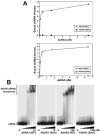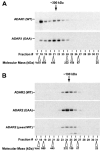RNA binding-independent dimerization of adenosine deaminases acting on RNA and dominant negative effects of nonfunctional subunits on dimer functions
- PMID: 17428802
- PMCID: PMC2954279
- DOI: 10.1074/jbc.M611392200
RNA binding-independent dimerization of adenosine deaminases acting on RNA and dominant negative effects of nonfunctional subunits on dimer functions
Abstract
RNA editing that converts adenosine to inosine in double-stranded RNA (dsRNA) is mediated by adenosine deaminases acting on RNA (ADAR). ADAR1 and ADAR2 form respective homodimers, and this association is essential for their enzymatic activities. In this investigation, we set out experiments aiming to determine whether formation of the homodimer complex is mediated by an amino acid interface made through protein-protein interactions of two monomers or via binding of the two subunits to a dsRNA substrate. Point mutations were created in the dsRNA binding domains (dsRBDs) that abolished all RNA binding, as tested for two classes of ADAR ligands, long and short dsRNA. The mutant ADAR dimer complexes were intact, as demonstrated by their ability to co-purify in a sequential affinity-tagged purification and also by their elution at the dimeric fraction position on a size fractionation column. Our results demonstrated ADAR dimerization independent of their binding to dsRNA, establishing the importance of protein-protein interactions for dimer formation. As expected, these mutant ADARs could no longer perform their catalytic function due to the loss in substrate binding. Surprisingly, a chimeric dimer consisting of one RNA binding mutant monomer and a wild type partner still abolished its ability to bind and edit its substrate, indicating that ADAR dimers require two subunits with functional dsRBDs for binding to a dsRNA substrate and then for editing activity to occur.
Figures






Similar articles
-
Dimerization of ADAR1 modulates site-specificity of RNA editing.Nat Commun. 2024 Nov 21;15(1):10051. doi: 10.1038/s41467-024-53777-2. Nat Commun. 2024. PMID: 39572551 Free PMC article.
-
Asymmetric dimerization of adenosine deaminase acting on RNA facilitates substrate recognition.Nucleic Acids Res. 2020 Aug 20;48(14):7958-7972. doi: 10.1093/nar/gkaa532. Nucleic Acids Res. 2020. PMID: 32597966 Free PMC article.
-
Requirement of dimerization for RNA editing activity of adenosine deaminases acting on RNA.J Biol Chem. 2003 May 9;278(19):17093-102. doi: 10.1074/jbc.M213127200. Epub 2003 Mar 4. J Biol Chem. 2003. PMID: 12618436
-
The role of dsRNA A-to-I editing catalyzed by ADAR family enzymes in the pathogeneses.RNA Biol. 2024 Jan;21(1):52-69. doi: 10.1080/15476286.2024.2414156. Epub 2024 Oct 24. RNA Biol. 2024. PMID: 39449182 Free PMC article. Review.
-
RNA Editing by ADAR Adenosine Deaminases: From Molecular Plasticity of Neural Proteins to the Mechanisms of Human Cancer.Biochemistry (Mosc). 2019 Aug;84(8):896-904. doi: 10.1134/S0006297919080054. Biochemistry (Mosc). 2019. PMID: 31522671 Review.
Cited by
-
ADAR1 RNA editing enzyme regulates R-loop formation and genome stability at telomeres in cancer cells.Nat Commun. 2021 Mar 12;12(1):1654. doi: 10.1038/s41467-021-21921-x. Nat Commun. 2021. PMID: 33712600 Free PMC article.
-
Recent Advances in Adenosine-to-Inosine RNA Editing in Cancer.Cancer Treat Res. 2023;190:143-179. doi: 10.1007/978-3-031-45654-1_5. Cancer Treat Res. 2023. PMID: 38113001 Review.
-
Adenosine deaminase acting on RNA (ADAR1), a suppressor of double-stranded RNA-triggered innate immune responses.J Biol Chem. 2019 Feb 1;294(5):1710-1720. doi: 10.1074/jbc.TM118.004166. J Biol Chem. 2019. PMID: 30710018 Free PMC article. Review.
-
Bi-allelic ADARB1 Variants Associated with Microcephaly, Intellectual Disability, and Seizures.Am J Hum Genet. 2020 Apr 2;106(4):467-483. doi: 10.1016/j.ajhg.2020.02.015. Epub 2020 Mar 26. Am J Hum Genet. 2020. PMID: 32220291 Free PMC article.
-
New Insights into the Biological Role of Mammalian ADARs; the RNA Editing Proteins.Biomolecules. 2015 Sep 30;5(4):2338-62. doi: 10.3390/biom5042338. Biomolecules. 2015. PMID: 26437436 Free PMC article. Review.
References
-
- DeCerbo J, Carmichael GG. Curr Opin Cell Biol. 2005;17:302–308. - PubMed
-
- Reenan RA. Trends Genet. 2001;17:53–56. - PubMed
-
- Toth AM, Zhang P, Das S, George CX, Samuel CE. Prog Nucleic Acid Res Mol Biol. 2006;81:369–434. - PubMed
-
- Higuchi M, Single FN, Kohler M, Sommer B, Sprengel R, Seeburg PH. Cell. 1993;75:1361–1370. - PubMed
Publication types
MeSH terms
Substances
Grants and funding
LinkOut - more resources
Full Text Sources
Other Literature Sources
Research Materials

